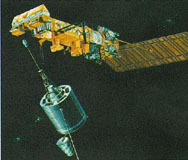![]()
The first satellite in the Cospas-Sarsat system was launched in 1982. By 1984 the Cospas-Sarsat system was considered operational.
 The Cospas-Sarsat system is able to monitor the entire world because of the series of low-altitude satellites in near-polar orbits. By working together, the satellites provide complete coverage of the Earth, including the polar regions.
The Cospas-Sarsat system is able to monitor the entire world because of the series of low-altitude satellites in near-polar orbits. By working together, the satellites provide complete coverage of the Earth, including the polar regions.
Anywhere on Earth, a user can activate an emergency beacon to signal distress. When the emergency beacon is activated, the signal is received by a Cospas-Sarsat satellite and relayed to the nearest available ground station. The ground station, called a Local User Terminal (LUT), processes the signal and calculates the position of the distress signal. This position is sent to a mission control centre where it is joined with identification data and other information on that beacon. The mission control centre then informs a rescue coordination centre nearest the beacon that is sending out the distress signal. If the beacon is in another country's service area, then the alert is transmitted to that country's mission control centre. The Cospas-Sarsat beacons are emitting a signal of frequency 406 MHz, and with these beacons a distress signal can be sent from anywhere on Earth 24 hours a day, 365 days a year.
Each satellite in the Cospas-Sarsat system makes a complete orbit of the Earth around the poles in about 100 minutes, travelling at a velocity of seven kilometres per second. The satellite views a region of the earth over 4000 km wide as it circles the globe, giving it a field of view, at any one time, the size of a continent. When viewed from the earth, the satellite crosses the sky in about 15 minutes.
All of the polar orbiting satellites in the Cospas-Sarsat system carry a Search and Rescue Repeater (SARR) which receives and retransmits 121.5 MHz and 243 MHz signals any time the satellite is in view of a ground station. After amplification and frequency conversion, the signals are retransmitted on the 1544.5 MHz downlink. Automatic Level Control (ALC), a feature of the repeater, is provided to maintain a constant output level. The SARR is a project of the Canadian Department of National Defence.
The satellites involved in the Cospas-Sarsat system carry equipment specific to their function as search and rescue spacecrafts. This equipment consists of a 121.5 MHz repeater unit on Cospas satellites and a 121.5, 243 and 406 MHz repeater unit on Sarsat satellites, designed for retransmission of distress signals in the local coverage mode. There is a receiver-processor and memory unit on Cospas and Sarsat satellites designed to receive, process and store signals received on 406 MHz for retransmission in the local and the global coverage mode. Its purpose is to demodulate the digital messages received from beacons, to measure the received frequency, and to record the time the measurement was taken.